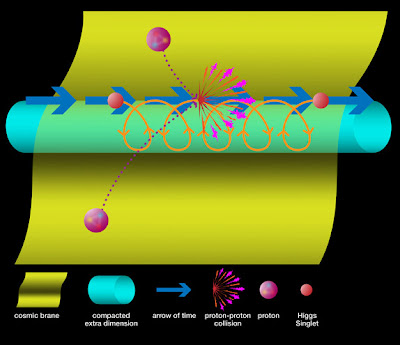Large Hadron Collider could be world’s first time machine | Research News @ Vanderbilt | Vanderbilt University
If the latest theory of Tom Weiler and Chui Man Ho is right, the Large Hadron Collider – the world’s largest atom smasher that started regular operation last year – could be the first machine capable of causing matter to travel backwards in time.
“Our theory is a long shot,” admitted Weiler, who is a physics professor at Vanderbilt University, “but it doesn’t violate any laws of physics or experimental constraints.”
One of the major goals of the collider is to find the elusive Higgs boson: the particle that physicists invoke to explain why particles like protons, neutrons and electrons have mass. If the collider succeeds in producing the Higgs boson, some scientists predict that it will create a second particle, called the Higgs singlet, at the same time.
According to Weiler and Ho’s theory, these singlets should have the ability to jump into an extra, fifth dimension where they can move either forward or backward in time and reappear in the future or past.
“One of the attractive things about this approach to time travel is that it avoids all the big paradoxes,” Weiler said. “Because time travel is limited to these special particles, it is not possible for a man to travel back in time and murder one of his parents before he himself is born, for example. However, if scientists could control the production of Higgs singlets, they might be able to send messages to the past or future.”
Illustration of singlet time travel theory. When a pair of protons collide in the Large Hadron Collider, the resultant explosion may create a special type of particle, called a Higgs singlet, that is capable of traveling forward and back in time. It would do so by leaving familiar three-dimensional space to travel in an extra dimension. (Jenni Ohnstad / Vanderbilt)
Weiler and Ho’s theory is based on M-theory, a “theory of everything.” A small cadre of theoretical physicists have developed M-theory to the point that it can accommodate the properties of all the known subatomic particles and forces, including gravity, but it requires 10 or 11 dimensions instead of our familiar four. This has led to the suggestion that our universe may be like a four-dimensional membrane or “brane” floating in a multi-dimensional space-time called the “bulk.”
Collected from: Large Hadron Collider could be world’s first time machine | Research News @ Vanderbilt | Vanderbilt University
Higgs boson - Wikipedia, the free encyclopedia
The Higgs boson is a hypothetical massive elementary particle predicted to exist by the Standard Model of particle physics. The existence of the particle is postulated as a means of resolving inconsistencies in current theoretical physics, and attempts are being made to confirm the existence of the particle by experimentation, using the Large Hadron Collider (LHC) at CERN and the Tevatron at Fermilab.
A simulated event, featuring the appearance of the Higgs boson
Collected from: Higgs boson - Wikipedia, the free encyclopedia
Introduction to M-theory - Wikipedia, the free encyclopedia
[...]In the 1980s, a new mathematical model of theoretical physics called string theory emerged. It showed how all the particles, and all of the forms of energy in the universe, could be constructed by hypothetical one-dimensional "strings", infinitely small building-blocks that have only the dimension of length, but not height nor width. Further, string theory suggested that the universe is made up of multiple dimensions. Height, width, and length constitute three-dimensional space, and time gives a total of four observable dimensions; however, string theories initially supported the possibility of ten dimensions – the remaining six of which we cannot detect directly. This was later increased to 11 dimensions based on various interpretations of the ten dimensional theory that led to five partial theories as described below. Super-gravity theory also played a significant part in establishing the existence of the 11th dimension.[...]
In the mid-1990s, a string theorist named Edward Witten of the Institute for Advanced Study and other important researchers considered that the five different versions of string theory might be describing the same thing seen from different perspectives. They proposed a unifying theory called "M-theory", in which the "M" is not specifically defined, but is generally understood to stand for "membrane".
Collected from: Introduction to M-theory - Wikipedia, the free encyclopedia
Related



